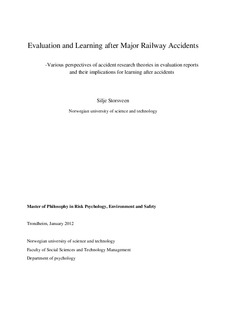| dc.contributor.advisor | Sjöberg, Britt-Marie Drottz | nb_NO |
| dc.contributor.author | Storsveen, Silje | nb_NO |
| dc.date.accessioned | 2014-12-19T14:42:22Z | |
| dc.date.available | 2014-12-19T14:42:22Z | |
| dc.date.created | 2012-05-25 | nb_NO |
| dc.date.issued | 2012 | nb_NO |
| dc.identifier | 528469 | nb_NO |
| dc.identifier.uri | http://hdl.handle.net/11250/270820 | |
| dc.description.abstract | Accident causation has been differently approached and evaluated in the last decades. This thesis studies four large accidents in the Norwegian railway organization, i.e. the Tretten accident, the Nordstrand accident, the Åsta accident and the Alnabru/Sjursøya accident. Accident causation was investigated by systematically reviewing and comparing the respective accidents‟ evaluation reports to three dominant accident research theories: The Energy and Barrier theory, the Man-made Disaster theory and the Normal Accident theory. It is concluded that the development of the accident evaluation reports throughout a time period of 35 years initially developed from simple cause-effect relationships implemented mainly by local technical safety barriers to more recent strategies including an increasing number of indirect causes with following recommendations within non-technical areas, as communication processes and management strategies. The official accident reports evaluating the Tretten and the Nordstrand accidents focused on the immediate failures leading to the accidents. The two latter reports, evaluating the Åsta and Alnabru/Sjursøya accidents emphasized to a larger degree the indirect causes contributing to the accidents, as well as the decisive failures. From a theoretical point of view it is concluded that the stated causation with attached recommendations characterizing the Åsta and Alnabru/Sjursøya accidents provided a higher organizational learning potential than the stated causation of the Tretten and the Nordstrand accidents. This conclusion is mainly based upon the limited and narrow view of causation and recommendations in the available evaluation reports after the Tretten and Nordstrand accidents. After the Åsta and Alnabru/Sjursøya accidents, the respective Commission of inquiry presented a specific as well as general view, relating the causation, and recommendations, for the future to several levels in the organization. However, if indirect causation and following recommendations are too broad, difficulties might arise locating the failures and implementing corrections. From a theoretical perspective, indirect causation enhances organizational learning, but it may also lead to abstract and broader recommendations which are harder to implement in the system due to modern organization‟s continuous increase in complexity of components and interactions. It is concluded that to ensure enhanced organizational learning accident evaluation has to be more specifically adapted to organizational structures, i.e. adapted to both the formal and informal structures of an organization as well as focused on the practical consequences of the implementations. | nb_NO |
| dc.language | eng | nb_NO |
| dc.publisher | Norges teknisk-naturvitenskapelige universitet, Fakultet for samfunnsvitenskap og teknologiledelse, Psykologisk institutt | nb_NO |
| dc.subject | Social and Behavioural Science, Law | en_GB |
| dc.title | Evaluation and Learning after Major Railway Accidents: Various perspectives of accident research theories in evaluation reports and their implications for learning after accidents | nb_NO |
| dc.type | Master thesis | nb_NO |
| dc.source.pagenumber | 75 | nb_NO |
| dc.contributor.department | Norges teknisk-naturvitenskapelige universitet, Fakultet for samfunnsvitenskap og teknologiledelse, Psykologisk institutt | nb_NO |
